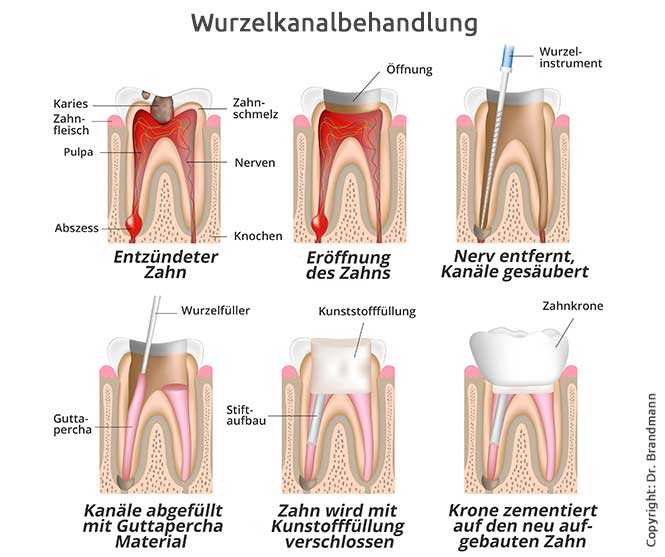
root canal treatment
Root canal treatment instead of tooth extraction
The tooth has to go out? This does not have to be the case in most cases, because a root canal treatment can save even a very damaged tooth!
How to save your teeth with a root canal treatment:
- Removal of the tooth nerve
- Preparation of the root canals
- Closure of the tooth roots
Table of Contents
Root canal treatment
When does a root canal treatment become necessary??
Remove inflammation, relieve pain, save teeth
Inside a healthy tooth is the pulp. In case of deep caries or if a large piece of the tooth breaks off, bacteria can enter the tooth pulp. In rare cases, the pulp may also be infected via a deep periodontal pocket. This can lead to a very painful and tissue-damaging inflammation. The further penetration of the pathogens and the degradation products of the dying dental pulp then cause a defense reaction of the body around the root.
An inflammation of the tooth root can exist over a longer period painlessly and unnoticed. However, this inflammation is an interfering field in the body and can trigger symptoms elsewhere. The site of inflammation can change into an acute state at any time. This manifests itself u.a. due to bite symptoms or purulent abscesses with a swelling in the area of the root tip.
Sequence of a root canal treatment
The treatment begins with an X-ray. The X-ray image not only shows the extent of caries or inflammation at the apex of the root, but also provides information about the anatomy and the preliminary preparation length.
In a root canal treatment, the greatest possible freedom of bacteria in the root canal system is essential. For the production of a sterile working area, we therefore work with a cofferdam if required. The cofferdam is a rubber that is stretched over the tooth to protect the tooth interior from bacteria in the oral cavity.
The dental crown provides access to the root canal system. This step should be done extremely carefully with magnifying glasses or a surgical microscope. Through this careful work the essential anatomical structures are obtained; the tooth is not weakened unnecessarily.
The side channels in the root canal are cleaned with ultrasound. In addition, disinfecting rinsing solutions are used for detaching and flushing out organic residues in the root canal.
In the next treatment session, the definitive and edge-tight filling of the root canal system usually takes place. With an adhesive filling therapy a later bacterial entry, the so-called “microleakage”, should be prevented. To prevent overfilling or underfilling of the root canals, the channel lengths are measured electronically. The filling is done with the natural material gutta-percha. It can also be a thermoplastic polyester, a so-called. “Monoblock” glued.
After the treatment, two final x-ray control shots usually need to be made to check the length and integrity of the root canal.
Root Tip Resection (WSR) – Last rescuing the tooth before tooth extraction
Root-tip resection is often the last option for obtaining a tooth. Root-tip resection may be necessary if inflammation does not completely heal despite careful root canal treatment.
Access to the root tip can be created via the tooth crown (orthograd) or laterally over the jawbone (retrograde). During treatment, a few millimeters of the root tip and inflamed tissue are removed. This is followed by filling and closure of the cleaned root canal opening.
Duration of a root canal treatment
A root canal system is very complex; the structures are not always immediately recognizable. A careful root canal treatment can therefore last for several sessions; but usually two to four hours are enough. The treatment method is today gentler and more effective, so that the effort in comparison to the benefit is clearly worthwhile.
Success prospects of a root canal treatment
Root-treated teeth have no temperature sensation. The tactile sensation persists, however, as the nerves in the periodontium are preserved. The modern root canal treatment offers great opportunities to keep a diseased tooth healthy again and long-term inflammation-free. Rarely, the channels are so branched that a treatment is not possible.
Root treatment weakens the tooth and can also turn gray. Root-treated teeth should therefore be treated with a crown or partial crown to protect the tooth from breakup or reinfection.
The bone surrounding the root of the tooth takes about six to twelve months to regenerate after treatment. The German Society for Dental Care specifies a success rate of up to 95 percent for root canal treatment.
A root-treated and ceramic-treated tooth can perform its full service in the mouth for a lifetime. Important are regular checks and regular professional teeth cleaning!
Alternatives to a root canal treatment
The only alternative to root canal treatment is to pull the tooth. This gap must then be replaced by a bridge or an implant.
Related Posts
-

Endodontics frankfurt: root canal treatment for root inflammation
Root canal treatment – endodontics (root canal treatment) Successful and painless treatment of tooth root inflammation with laser at dentist P. Tomovic…
-

Root canal treatment root canal treatment frankfurt westend – dentist westend frankfurt dr
Root Canal: Get your own teeth Avoid high costs for dentures and implants Teeth inside have a cavity filled with blood vessels, nerves and connective…
-

Root canal ingolstadt, dentist dr
Modern root canal treatment (endodontics) When a tooth needs to be saved … In our dental office Ulmer, Valentinis Colleagues is the long-term…
-

Faq root canal treatment – dentist ingolstadt
FAQ Root treatment In this section we answer your most frequently asked questions from our consultation on a specific topic. This time on the topic…
